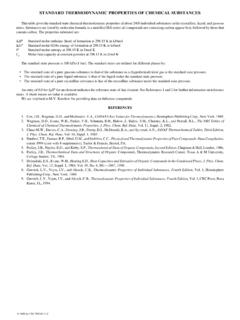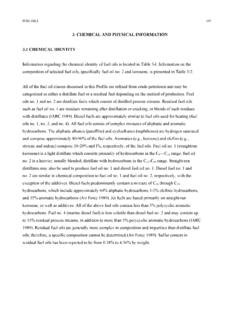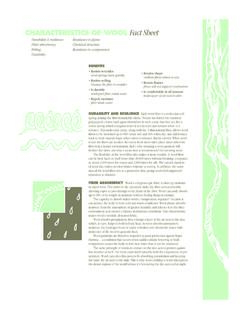Transcription of Physical & Chemical Properties - Cancarb
1 Physical & Chemical Properties Properties Carbon black can be broadly defined as very fine particulate aggregates of carbon possessing an amorphous quasi-graphitic molecular structure. The most significant areas of distinction between a thermal black and a furnace black are particle size and structure. Most carbon blacks are classified and assigned a grade number based on surface area and structure measurements. Sieve Residue Sieve residue refers to non-dispersable contaminants (such as coke, refractory particles, water soluble salts and metal oxides) and is expressed as a percentage of the carbon black by weight. Sixty and 325 Mesh sieves are used for this test. The resulting grit can cause blemishes and may affect the appearance and performance of some rubber and plastic products.
2 The 325 Mesh grit is also tested for magnetic content. Surface Area Surface area measurements give an indirect characterization of carbon black particle size. There are two methods in use for surface area determination. Iodine adsorption (expressed in mg/g of carbon) measures the amount of iodine which can be adsorbed on the surface of a given mass of carbon black. Nitrogen surface area is a measurement of the amount of nitrogen which can be adsorbed on a given mass of carbon black. Both tests have a good correlation for most rubber grades of furnace blacks, but toluene extractables on the surface of thermal blacks interfere with the aqueous iodine-potassium system of the iodine adsorption method, making nitrogen surface area a more suitable test.
3 Accordingly, the American Society for Testing and Materials (ASTM) does not recommend iodine adsorption for surface area measurements of thermal blacks. Based on surface area, thermal black is classified as an N900 series black while furnace blacks fall within the N100 to N700 series. (N) denotes normal curing material. Thermal black has the largest particle size (mean diameters of 240 - 320 nm) of any carbon black and hence has the lowest surface area at 7 - 11 m2/g. In contrast, furnace black particle sizes are approximately three to twenty times smaller (mean diameters of 15 - 80 nm) providing surface areas from 27 - 145 m2/g. The particle size of thermal black is shown in comparison with the smallest and largest particle size furnace blacks in Figure 1.
4 Figure 1: Carbon Black Particle Size Comparison Mean DiametersNN776622 NN111100 NN999900 ((8800nnmm)) ((228800nnmm)) ((1155nnmm)) Structure Measuring the structure or morphology of carbon black is a more difficult task. The current industry test index is the dibutyl phthalate absorption number (DBPA). Dibutyl phthalate (DBP) absorption measures the relative structure of carbon black by determining the amount of DBP a given mass of carbon black can absorb before reaching a specified viscous paste. Thermal blacks have the lowest DBPA numbers (32-47 ml/100g) of any carbon black, indicating very little particle aggregation or structure. Electron micrographs of thermal blacks show a large number of individual spherical carbon particles.
5 At the same time, aggregates are very limited and consist of no more than a few fused particles. Furnace blacks on the other hand do not consist of individual spheres of carbon but exhibit a rather wide range of particle aggregations in which carbon particles are fused into grape-like clusters and/or reticulate chains or branches. Even the lowest structure furnace blacks can be considered as having moderate structure (DBPA: 65 ml/100 g). High structure furnace black has the greatest amount of reticulation. Figure 2 provides a graphical representation of relative carbon black structure. Figure 2: Carbon Black Structure Comparison (Particle sizale) ore recently, non-integer dimensional analysis (fractal geometry) has been he analyses of thermal black (Figure 3) indicates it contains the highest level of Low Structure Moderate Structure High StructureN990 N762N121 es not to sc Mused to classify carbon blacks according to four simple aggregate shape categories: spherical, ellipsoidal, linear and branched.
6 Tsimple spherical and ellipsoidal shapes, which act as essentially independent discrete particles like those seen in electron micrographs. Figure 3: Weight Percentage of Aggregates in four Shape Categories for Various Carbon Black Grades (Dry State) Carbon Black DBPA cm3/100g SpheroidalEllipsoidalLinear Branched N358 155 N121 134 N650 129 N234 124 N299 124 N351 120
7 N550 120 N339 118 N110 115 N220 115 N330 100 N660 91 N630 78 N774 77 N326 72 N762 67 N990 35 By plotting surface area against structure the distinction between the different grades of carbon black becomes readily apparent.
8 Thermal black is at the extreme end of such a plot while the numerous grades of furnace black cover a wide range of values (Figure 4). Figure 4: Structure vs. Surface Area 140120100806040200 DIBUTYL PHTHALATE ABSORPTION (ml/100g)0 20 40 60 80 100 120 140 160 NITROGEN SURFACE AREA (m^2/g)N650N765N539N660N787N774N762N754N 990N343N347N339N375N330N326N121N234N220N 231N110N293 Ash Content Ash level is highly dependent on the amount of inorganic impurities present in the cooling water. It consists primarily of sodium, magnesium and calcium, but also contains minute amounts of other metals. Toluene Extraction Minute amounts of polyaromatic hydrocarbons are usually present in thermal black.
9 There is always the possibility that they may leach from the carbon black and stain adjoining compounds. Cancarb uses two tests to determine the amount of polyaromatic hydrocarbons in its thermal black. Toluene discoloration consists of washing a specified amount of sample with toluene and comparing the spectrophotometric readings of the washings with that of the pure toluene. A more quantitative measurement of polyaromatic hydrocarbon content is Toluene Extraction, in which the hydrocarbons are removed from a crushed carbon black sample by Soxhlet extraction. Heat Loss The heating loss of carbon black is important in determining its moisture content. The amount of moisture present is related to: the surface area of the black, relative humidity, ambient temperature and the time for which the material is exposed.
10 Thermal blacks have the lowest surface area per unit mass of all carbon blacks and therefore absorb an insignificant amount of moisture. The heat loss determination is made at 125 C. Fines Fines are the pellets and pellet fragments that pass through a 125 micron sieve ( Standard Sieve series) after being shaken for 5 minutes. The amount of fines in a product can affect its ability to flow, raise dust levels during handling, and decrease dispersion in final rubber and plastics compounds due to the higher surface area associated with smaller pellets. Pellet Hardness Pellet hardness is the force required to crush an individual pellet which is between 1000 and 1410 micron sieve ( Standard Sieve and ).








